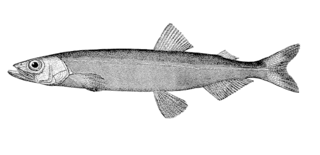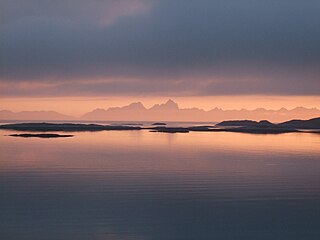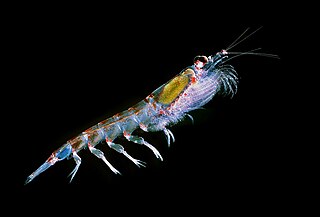The Joint Norwegian–Russian Fisheries Commission is a bilateral fisheries management body run by Norway and Russia to control Barents Sea fishing, established in 1976. [1] [2]
Fisheries management is the activity of protecting fishery resources so sustainable exploitation is possible, drawing on fisheries science, and including the precautionary principle. Modern fisheries management is often referred to as a governmental system of appropriate management rules based on defined objectives and a mix of management means to implement the rules, which are put in place by a system of monitoring control and surveillance. A popular approach is the ecosystem approach to fisheries management. According to the Food and Agriculture Organization of the United Nations (FAO), there are "no clear and generally accepted definitions of fisheries management". However, the working definition used by the FAO and much cited elsewhere is:
The integrated process of information gathering, analysis, planning, consultation, decision-making, allocation of resources and formulation and implementation, with enforcement as necessary, of regulations or rules which govern fisheries activities in order to ensure the continued productivity of the resources and the accomplishment of other fisheries objectives.

Norway, officially the Kingdom of Norway, is a Nordic country in Northern Europe whose territory comprises the western and northernmost portion of the Scandinavian Peninsula; the remote island of Jan Mayen and the archipelago of Svalbard are also part of the Kingdom of Norway. The Antarctic Peter I Island and the sub-Antarctic Bouvet Island are dependent territories and thus not considered part of the kingdom. Norway also lays claim to a section of Antarctica known as Queen Maud Land.

Russia, officially the Russian Federation, is a transcontinental country in Eastern Europe and North Asia. At 17,125,200 square kilometres (6,612,100 sq mi), Russia is by far or by a considerable margin the largest country in the world by area, covering more than one-eighth of the Earth's inhabited land area, and the ninth most populous, with about 146.77 million people as of 2019, including Crimea. About 77% of the population live in the western, European part of the country. Russia's capital, Moscow, is one of the largest cities in the world and the second largest city in Europe; other major cities include Saint Petersburg, Novosibirsk, Yekaterinburg and Nizhny Novgorod. Extending across the entirety of Northern Asia and much of Eastern Europe, Russia spans eleven time zones and incorporates a wide range of environments and landforms. From northwest to southeast, Russia shares land borders with Norway, Finland, Estonia, Latvia, Lithuania and Poland, Belarus, Ukraine, Georgia, Azerbaijan, Kazakhstan, China, Mongolia and North Korea. It shares maritime borders with Japan by the Sea of Okhotsk and the U.S. state of Alaska across the Bering Strait. However, Russia recognises two more countries that border it, Abkhazia and South Ossetia, both of which are internationally recognized as parts of Georgia.
During the Soviet Era, the main issues were quotas (for the three major fish stocks defined as joint stocks: cod (50%-50%), haddock (50%-50%), and capelin (60%-40% in favour of Norway), fish size and mesh size.

Cod is the common name for the demersal fish genus Gadus, belonging to the family Gadidae. Cod is also used as part of the common name for a number of other fish species, and some species suggested to belong to genus Gadus are not called cod.

The haddock is a saltwater fish from the family Gadidae, the true cods, it is the only species in the monotypic genus Melanogrammus. It is found in the North Atlantic Ocean and associated seas where it is an important species for fisheries, especially in northern Europe. It is also an important food fish and it is marketed fresh, frozen and smoked; smoked varieties include the Finnan haddie and the Arbroath smokie.

The capelin or caplin is a small forage fish of the smelt family found in the North Atlantic, North Pacific, and Arctic oceans. In summer, it grazes on dense swarms of plankton at the edge of the ice shelf. Larger capelin also eat a great deal of krill and other crustaceans. Among others, whales, seals, Atlantic cod, Atlantic mackerel, squid, and seabirds prey on capelin, in particular during the spawning season of the capelin while it migrates southwards. Capelin spawn on sand and gravel bottoms or sandy beaches at the age of 2–6 years, and have an extremely high mortality rate on the beaches after spawning, for males close to 100%. Males reach 20 cm (8 in) in length, while females are up to 25.2 cm (10 in) long. They are olive-colored dorsally, shading to silver on sides. Males have a translucent ridge on both sides of their bodies. The ventral aspects of the males iridesce reddish at the time of spawn.
In 1993 the scope of the Commission included the compliance control, including exchange of catch data and inspections and coordination of various activities. This happened after it was revealed that after the dissolution of the Soviet Union Russian fishing vessels started delivering their catch to Norway rather than to Russia. However the catch data exchange failed to serve its purpose since late 1990s when Russian ships started to hand the frozen fish to transport ships heading to third countries. [2]

The dissolution of the Soviet Union occurred on 26 December 1991, officially granting self-governing independence to the Republics of the Union of Soviet Socialist Republics (USSR). It was a result of the declaration number 142-Н of the Supreme Soviet of the Soviet Union. The declaration acknowledged the independence of the former Soviet republics and created the Commonwealth of Independent States (CIS), although five of the signatories ratified it much later or did not do so at all. On the previous day, 25 December, Soviet President Mikhail Gorbachev, the eighth and final leader of the USSR, resigned, declared his office extinct and handed over its powers—including control of the Soviet nuclear missile launching codes—to Russian President Boris Yeltsin. That evening at 7:32 p.m., the Soviet flag was lowered from the Kremlin for the last time and replaced with the pre-revolutionary Russian flag.

A fishing vessel is a boat or ship used to catch fish in the sea, or on a lake or river. Many different kinds of vessels are used in commercial, artisanal and recreational fishing.
With end of the Cold War the work of the Commission included long-term strategies for the fish stock in the Barents Sea. [2]

The Cold War was a period of geopolitical tension between the Soviet Union with its satellite states, and the United States with its allies after World War II. A common historiography of the conflict begins between 1946, the year U.S. diplomat George F. Kennan's "Long Telegram" from Moscow cemented a U.S. foreign policy of containment of Soviet expansionism threatening strategically vital regions, and the Truman Doctrine of 1947, and ending between the Revolutions of 1989, which ended communism in Eastern Europe, and the 1991 collapse of the USSR, when nations of the Soviet Union abolished communism and restored their independence. The term "cold" is used because there was no large-scale fighting directly between the two sides, but they each supported major regional conflicts known as proxy wars. The conflict split the temporary wartime alliance against Nazi Germany and its allies, leaving the USSR and the US as two superpowers with profound economic and political differences.













